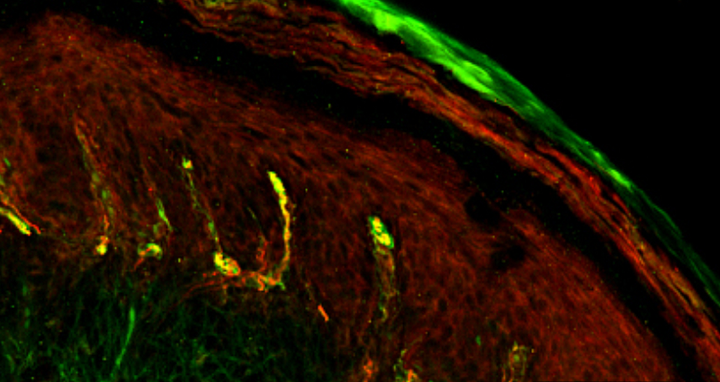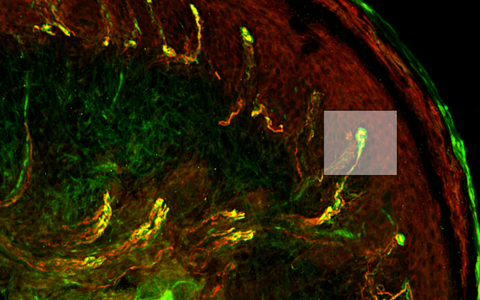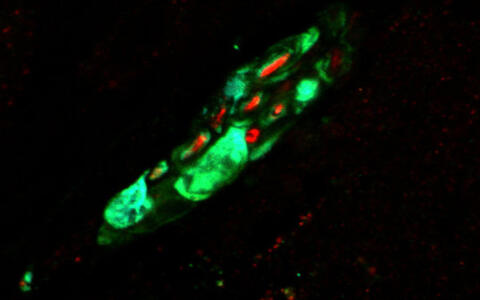Feeling out fine differences in touch sensitivity
A large protein produced in a unique structure in the fingertips, called the Meissner corpuscle, plays a major role in touch sensitivity, new research finds. Identified in the 1850s by Georg Meissner, the Meissner corpuscle is an oval-shaped capsule found in the fingertips and lips, filled with cells intertwined with a nerve ending that sends a “touch” signal to the brain.
“For a century and half, people have looked at the Meissner corpuscle and said ‘this is a beautiful structure, but we don’t really know what it’s there for,’” says Professor Gary Lewin, who heads the Molecular Physiology of Somatic Sensation Lab at the Max Delbrück Center for Molecular Medicine in the Helmholtz Association. In a new publication in the journal Nature Neuroscience, he and his team show that a protein made by the Meissner corpuscle is required to maintain normal touch perception.
The Usher connection
Based on previous research into the interplay between hearing and touch sensory systems, Lewin and his colleagues suspected that the protein USH2A may be involved in touch. Mutations in the gene, that codes for the USH2A protein, are common in Usher syndrome an inherited human disease, which includes hearing loss, tunnel vision and some loss of touch sensitivity.
Cross section through the skin with a number of Meissner receptors, one is highlighted in a box.
To investigate, the researchers worked with 13 Spanish patients with Usher syndrome who have specific mutations affecting the USH2A protein. They wanted to find out what was the smallest vibration the patients could perceive on their little finger. The researchers also tested their perceptions of temperature changes and small pin pricks. They conducted the same tests on healthy volunteers, mostly colleagues from the MDC, to compare results.
The patients with Usher syndrome could sense temperature changes and mild pain similar to the healthy controls, but had significantly reduced sensitivity to very small vibrations. Vibrations needed to be, on average, four times stronger before Usher patients could feel them.
“We are very sensitive to touch,” Lewin says. “If you have a very good sense of touch, you can detect with your finger, the difference between a very fine silk and an even finer silk. But the Usher patients would not be able to tell the difference.”
Surprising results
If you have a very good sense of touch, you can detect with your finger, the difference between a very fine silk and an even finer silk. But the Usher patients would not be able to tell the difference.
While the human studies showed the USH2A protein is important for touch, it did not explain how or why. So, the researchers turned to mice. First, Fred Schwaller, the lead author on the study, turned to the Neural Circuits and Behaviour Lab led by Professor James Poulet, who helped him train healthy mice and mice missing the USH2A protein to indicate when they felt very small vibrations on their forepaw. Just like the Usher patients, mice without USH2A proteins needed a larger stimulus before feeling the vibration, but detected temperature changes and mild pain normally, suggesting the mechanism has been highly conserved through evolution.
“It’s amazing to see the match between the patients and animal model. We were not expecting it to be so clear like that,” says Dr. Valérie Bégay, a scientist in Lewin’s lab who was involved in the study as well.
Looking closer with the help of fluorescent biomarkers, Schwaller found the protein is produced by the cells in the Meissner corpuscle, and not in nerve cells like they had expected. “To our surprise we could not detect the USH2A protein in sensory neurons, it wasn’t there,” Lewin says. This clearly demonstrated the Meissner corpuscle is essential for fine touch perception by producing the USH2A protein.
More to learn
The USH2A protein is quite large compared to other molecules in the body, and sits in the extracellular matrix of the corpuscle cells. Since touch sensitivity decreases when the protein is missing, Lewin theorizes that it serves as a physical connector, helping transmit touch vibrations from the outside of the fingertip to the nerve ending inside the corpuscle. His team is actively investigating the theory and he is interested to see what other elements the protein interacts with. “It is likely not working alone,” he says.
High resolution picture of the highlighted Meissner receptor with USH2A protein (green) and a sensory axon (red).
The insight might help with research into related hearing and vision loss in Usher patients. While it is unlikely the protein works the same way in those systems, it might provide some hints about how mutations in the USH2A gene affect those senses.
The researchers were especially appreciative of their colleagues at MDC who volunteered for the study, providing essential control data. More than 100 people over the past several years have participated. “You need good controls to increase confidence in your data, but it can be very difficult to get enough volunteers who are willing to concentrate closely for an hour or an hour and a half,” says Bégay. “The support from our MDC colleagues has been invaluable.”
Text: Laura Petersen
Further information
Changing how we think about warm perception
Downloadable images
Picture 1: Cross section through the skin with a number of Meissner receptors, one is highlighted in a box. © Lewin Lab, MDC
Picture 2: High resolution picture of the highlighted Meissner receptor with USH2A protein (green) and a sensory axon (red). © Lewin Lab, MDC
Literature
Schwaller, Fred et al. (2020): „USH2A is a Meissner corpuscle protein necessary for normal vibration sensing in mice and humans”, Nature Neuroscience, DOI: 10.1038/s41593-020-00751-y
Media contacts
Professor Gary Lewin
Head of the Lab “Molecular Physiology of Somatic Sensation”
Max Delbrück Center for Molecular Medicine in the Helmholtz Association (MDC)
glewin@mdc-berlin.de
Christina Anders
Editor, Communications Department
Max Delbrück Center for Molecular Medicine in the Helmholtz Association (MDC)
+49 (0)30 9406 2118
christina.anders@mdc-berlin.de or presse@mdc-berlin.de
The Max Delbrück Center for Molecular Medicine (MDC)
The Max Delbrück Center for Molecular Medicine in the Helmholtz Association (MDC) is one of the world’s leading biomedical research institutions. Max Delbrück, a Berlin native, was a Nobel laureate and one of the founders of molecular biology. At the MDC’s locations in Berlin-Buch and Mitte, researchers from some 60 countries analyze the human system – investigating the biological foundations of life from its most elementary building blocks to systems-wide mechanisms. By understanding what regulates or disrupts the dynamic equilibrium in a cell, an organ, or the entire body, we can prevent diseases, diagnose them earlier, and stop their progression with tailored therapies. Patients should benefit as soon as possible from basic research discoveries. The MDC therefore supports spin-off creation and participates in collaborative networks. It works in close partnership with Charité – Universitätsmedizin Berlin in the jointly run Experimental and Clinical Research Center (ECRC), the Berlin Institute of Health (BIH) at Charité, and the German Center for Cardiovascular Research (DZHK). Founded in 1992, the MDC today employs 1,600 people and is funded 90 percent by the German federal government and 10 percent by the State of Berlin.









